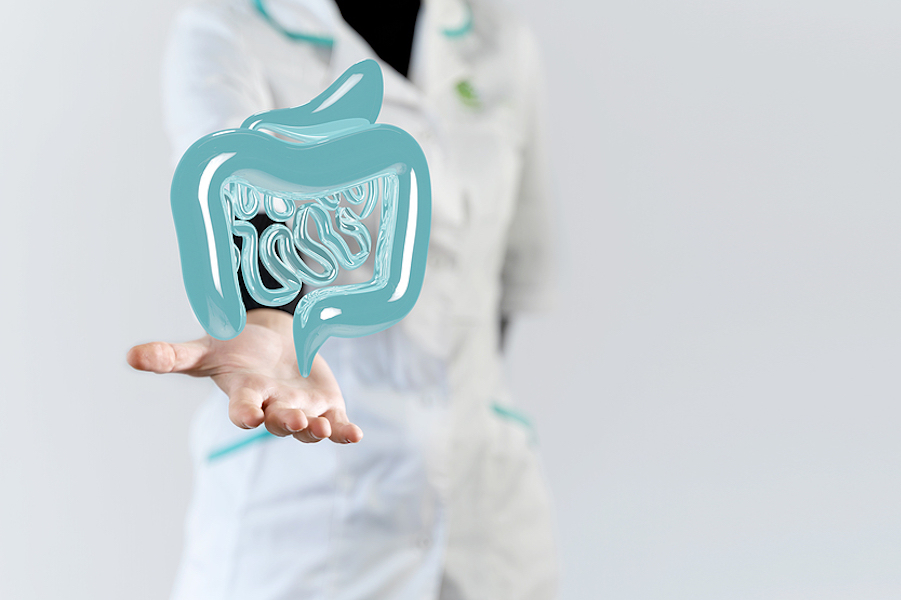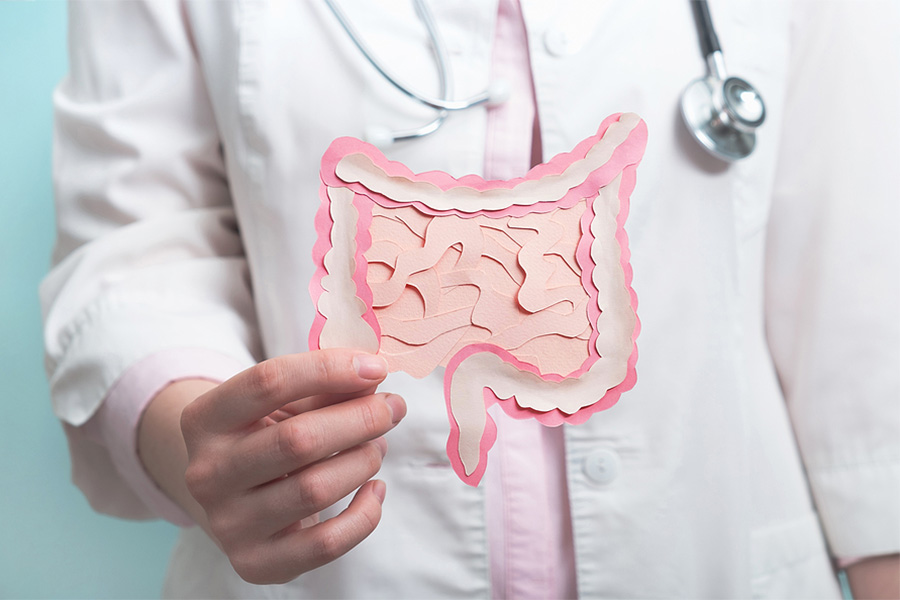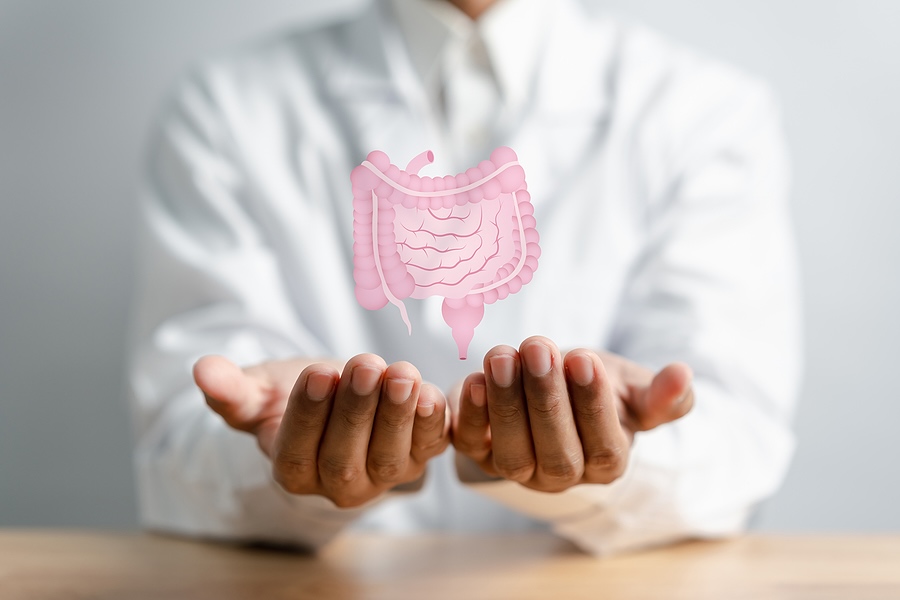Sometimes a patient will ask me what I consider to be the secrets of good health. Of course, they already know many of my “secrets” — my patients are very well-read. But frankly I am surprised by how few women know the importance of the tiny, ever-busy microorganisms that inhabit our digestive systems, and what can be done to help them flourish.
There are trillions of these microorganisms colonizing our bodies — tenfold more numerous than the cells of our bodies. When we are healthy, it is in large part because they are healthy. Called beneficial flora, these small friends digest and help us absorb our food, shore up our immune systems, even contribute to the manufacture of vitamins. The term probiotics, a word you may be hearing more often these days, refers to foods or supplements containing live beneficial microbes, primarily bacterial strains, that are used to fortify or rebuild our natural gut flora.
By contrast, impaired or imbalanced intestinal flora are implicated acute conditions and chronic diseases, including heart disease, allergies and asthma, skin disorders, obesity, IBS and digestive problems, some cancers, Alzheimer’s and much more. Daily probiotic use is an effective preventative and therapeutic measure to help keep the balance of intestinal flora tipped toward the positive side.
The truth is that feeling well depends on keeping your friendly bacteria happy. Think about how sick you feel when the unfriendly microorganisms get the upper hand with a case of food poisoning, Montezuma’s revenge, or intestinal flu. You can keep them happy with a good diet, good health habits, and supplementing with probiotics. Many dairy manufacturers are now advertising probiotic-enhanced foods, and natural food stores carry several varieties of probiotics. It can be overwhelming trying to choose what’s best — so let’s talk about what you need to know.
The flora in your GI tract — it’s a jungle in there!
Imagine that your mouth, intestines, colon and vagina are lush organic gardens, filled with exotic plants. Provided with adequate nutrients, water, beneficial insects and soil microbes, your gardens flourishes. Even when disease or pests present themselves, your garden gate is strong and the bad guys are easily repelled. But what happens when conditions are suboptimal, or the ground is razed? Your prized specimens weaken and succumb, pests and weeds take hold, and the whole delicate ecosystem is overrun.
At last count, scientists estimated that around 750 trillion bacteria, yeast and other microorganisms inhabit a healthy woman’s digestive system and vagina. They make up 3–5 pounds of your total body weight and outnumber your cells ten to one. In the buzzing metropolis of your GI tract, there is plenty of surface area for these microbes to colonize, but competition for real estate is high. Through a process of “competitive exclusion,” how you treat your body determines which bacteria get residence — good, bad or indifferent.
Of the trillions of microbes in your system, researchers have identified some — but by no means all — of the friendly flora species. Categorized through a complex process of culturing and DNA isolation, essential players include Escherichia, Lactobacillus, and Bifidobacterium. Other common inhabitants include Bacteroides, Clostridium, Fusobacterium, Eubacterium, Streptococcus and certain yeast (Candida) strains.
What’s truly amazing, though, is not just how many different kinds of these tiny creatures are present, but how complex the differences among them are. Individual species themselves can be beneficial or detrimental, for example, depending on a number of factors: their numbers; life stage; whether they’ve mutated into a beneficial or harmful strain (antibiotics impact this big time); location in your body; even which tinier microorganisms might be hyperparasitizing them!
This is the case with E. coli, Candida and strep. Regarding location, for example, E. coli behaves when it’s in your intestines and colon, but causes infection once it gets into your urinary tract. (That’s why it’s so important to wipe front-to-back when you use the bathroom!) As for hyperparasites, E. coli itself can contract a virus (a bacterio-phage = “eats bacteria”) and get wiped out. We are only just beginning to comprehend how complex life can be!
Over millennia, we’ve evolved a mutually beneficial, symbiotic relationship with our gut flora. As long as we provide a hospitable environment, they remain as paying guests, helping digestion and maintaining a balanced immunological response to potential allergens. As infants, our intestinal tract cannot mature efficiently without them. Many researchers believe that some allergies are rooted in a deficiency of friendly flora in childhood, resulting in an underdeveloped GI tract and compromised immune response.
Beneficial bacteria can be inhaled (like most microbes), but more often than not they find their way into the body in what we eat. Fermented foods like sauerkraut, kefir and yogurt contain active cultures of beneficial bacteria. The first beneficial microbe in our gut, Bifidobacterium infantis, is introduced through breast milk during the initial days of life, helping us digest milk sugars. As we mature, other species, like Lactobacillus, colonize the intestines, colon and vagina.
All these microorganisms are sensitive to acidity (pH) levels, and prefer their environments warm and dark. They flourish when they get the right food and languish when they don’t. What you eat early on influences which strains colonize your GI tract. Evidence suggests that a kind of microbial template is established in the early years of life that may reflect an individual’s initial diet and birth culture. This begs the question of whether inherited food sensitivities, like gluten intolerance, are more the product of primary gut flora or genetics. Perhaps research will tell us more in the future.
All gut flora are susceptible to sudden changes in their environment, and will die off in the millions when conditions aren’t right. Illness, stress, and antibiotic use affect the balance of microorganisms, as well as the speed of peristalsis (the wave-like action of the digestive system). But because gut flora get their food by breaking down what we eat, diet is the most important factor.
Beneficial bacteria, digestion and nutrition — a dynamic partnership
All gut flora have specific DNA codes that define their mechanism of action. Individual species inhabit certain sections of the GI tract and target certain sugars, proteins or fats for digestion. Scientists have only decoded about 10% of friendly gut flora, but even these preliminary data prove how dependent we are on them.
Many species of beneficial bacteria — such as Lactobacillus bulgaricus and L. thermophilus, which are used in fermenting yogurt, as well as the near-ubiquitous E. coli — manufacture B vitamins and vitamin K. They also break otherwise indigestible carbohydrates down into short-chain fatty acids, providing us with energy and nutrients. Other forms of bacteria digest proteins, freeing up amino acids for absorption. And some target the digestion and storage of fat, helping us normalize our cholesterol and triglyceride levels. Acidophilus and Bifidobacterium strains increase the bioavailability of minerals that need short-chain fatty acids for absorption, such as magnesium, iron, copper and manganese.
Good intestinal flora regulate bowel movements, and help prevent bloating, gas, and yeast overgrowth by controlling the pH level of the intestines through production of lactic acid. In babies, they stem diaper rash, diarrhea, and colic, as well as preventing allergies.
Gut flora and immunity
Beneficial bacteria reinforce the mucosal barrier of the intestines, which is associated with the gut-associated lymph tissue (GALT), helping to prevent pathogens, toxins and allergens from entering the rest of the body. In this way, their presence “teaches” the immune system which allergens and toxins are tolerable and which need to be disposed of.
Some bacteria have a stimulating effect on the immune system, by increasing T–cell counts, for example. In a study reported by the Annals of Nutrition and Metabolism, the number of certain T–lymphocytes that target cytotoxins (T2, T3 and T4) jumped by more than 28% in healthy young female test subjects after they ate conventional yogurt daily for one month.
Other good bacteria produce natural antibiotics and antifungals. For instance, Streptococcus salivarius manufactures an antiseptic that neutralizes the sulfur compounds responsible for bad breath (halitosis). Friendly flora also keep unfriendly bacteria in check by depriving them of nutrients and secreting acids (acetic, lactic, and formic) that create a hostile environment for pathogens.
Gut flora, hormones, and metabolism
Beneficial flora metabolize and recycle hormones, including estrogen, thyroid hormones, and phytoestrogens from food sources, which can help offset symptoms of menopause, PMS and perimenopause. In this way, they help maintain proper hormonal balance, and may protect bone and breast health as well. There is evidence that some probiotics may have anti-tumor, anti-cancer effects by helping us metabolize specific food components (like antioxidants and flavonoids) into useable forms.
Vaginal yeast infections and systemic yeast — an example
Candida albicans is a type of yeast organism that normally helps us digest carbohydrates. Candidiasis, or yeast overgrowth, is an example of what happens when there is an imbalance in the body environment. Like weeds in the garden, once the balance has been shifted toward the negative, it can take a lot of work to regain a desirable floral balance. Without proper and consistent attention, weeds will grow back and run riot, as in cases of chronic vaginitis or systemic yeast overgrowth.
While conventional doctors accept and treat the reality of vaginitis, there is still a lot of resistance in Western medicine to the concept of systemic yeast. But the truth is, the causes and effects of bacterial and yeast overgrowth, and thus the treatment protocol, are similar. The basic idea is this: weed out the bad guys through deprivation and antimicrobials, then repopulate with beneficial species.
Conventional medicine excels at the first part. There are scores of prescription antifungals and antibiotics that will knock out the invasive species. But not much is done about the second — and most important — phase: repopulation with good bacteria.
Using vaginitis as an example, we understand that when the good microbes are in the majority, they keep the vaginal environment slightly acidic and hostile to infectious agents. If the environment changes in pH from antibiotic use, illness, or poor dietary choices, the immune system is weakened. Then if infectious bacteria are introduced from the anus or other sources, the tables are quickly turned and infection established, marked by increased discharge, itching, burning, and odor.
In my practice, I tackle yeast vaginitis with a three-step approach. First I starve Candida of sugar, their favorite food, by recommending a sugar-free and yeast-free diet. Then I use an antimicrobial supplement, such as Candex, to decrease the number of yeast. Many women feel worse for a while as huge numbers of yeast die off, producing toxic by-products. Third, I counteract this “die-off effect” by inoculating the vagina and intestines with a good probiotic supplement.
In fact, it is not uncommon for a woman suffering from chronic vaginitis to take an antimicrobial two hours before a meal and then a probiotic with her meals. This yin-yang approach helps the good bacteria more quickly reestablish balance. I often tell patients with less severe yeast vaginitis to dip a tampon into plain, active-culture yogurt and insert it into the vagina for an hour to achieve a similar result.
For such an easy fix, it’s remarkable to me that more doctors don’t talk to women about probiotics, especially when antibiotics are prescribed so routinely — particularly for children.
Antibiotic use and intestinal flora — don’t throw baby out with the bath water…
Antibiotics have changed the course of human history. They have prolonged our lifespan by wiping out many of the infectious diseases that were the scourge of humanity for centuries. They are life-saving and absolutely essential — when used judiciously.
Broad-spectrum antibiotics work by wiping out most of the bacteria in your system. Other forms of antibiotics target certain strains of bacteria. Either way, it’s imperative that the right kinds of bacteria grow back once the bad strains have been decimated, or the bad guys will be back soon enough. Depending on your overall health, stress levels and diet, this repopulation often doesn’t take place, and other problems can develop as a result.
What’s more, bacteria are living, evolving organisms that can become resistant to chronic or improper antibiotic use and increasingly virulent. This is especially worrisome in children and the elderly. I think we are seeing now that treating every ear infection with antibiotics actually has a diminishing return.
Moreover, conventional medicine’s complete silence on the topic of probiotics doesn’t help matters. I am amazed by how many people are put on a course of antibiotics with no mention of what to do once they’re through. The good news is that using probiotics is easy and safe, even for children on antibiotics, the elderly, and those with compromised immune systems. And they may just help ward off further complications.
Who needs probiotics?
In my experience, everyone in our modern, industrialized culture could benefit from daily supplementation with probiotics. Our Western diet, filled with sugar, fatty meat and chemicals, along with our use of antibiotics, give unfriendly flora the advantage. How do you know if you have an imbalance, or could otherwise benefit from probiotics? Chances are if you’ve been sick or taken antibiotics recently, you need to repopulate the good bacteria in your system. Indications for probiotic use include symptoms of floral imbalance, as well as many other conditions:
- GI sensitivity (cramps, diarrhea/constipation)
- Bloating or foul-smelling gas
- Dysbiosis, including IBS or partially-digested stools
- Yeast infections, thrush, cold sores, diaper rash
- Headaches, migraines, joint aches
- Chronic bad breath/halitosis
- Rosacea, acne
- Fatigue, irritability
- Anorexia and/or bulimia
- Stuffy nose, increased mucous production
- Increased symptoms of PMS, perimenopause, or menopause
- Worsening sensitivity to sugar and fermented products
- Worsening symptoms of inflammatory conditions, like asthma
Although many of the above symptoms can indicate floral imbalance, they can also indicate more serious conditions. See your healthcare provider with any ongoing concerns.
A digestive stool analysis and allergy panel are both useful in determining the state of the flora in your gut. Genova Diagnostics provides several good options. Testing for yeast sensitivity and parasites may also be helpful. See our article on “Digestive System Problems – Causes And Diagnostics” for more information. Any woman taking antibiotics should supplement with probiotics during and for at least two weeks afterwards. I also recommend supplementing with probiotics during cold and flu season and to help ward off food poisoning and parasites while traveling.
Supporting probiotics with diet
It’s important to support probiotic use and your existing friendly flora through optimal nutrition, especially by minimizing refined sugar and processed foods in your diet. For more information refer to our nutritional and lifestyle guidelines.
Good bacteria feast on fiber. The bad guys love refined sugar and animal fat. Given a ready supply of vegetables, legumes and whole grains, good bacteria live long and prosper. Polyphenols, found in foods like garlic, green tea and ginseng, are also helpful in fostering friendly flora.
Fermented foods such as miso, tempeh, soy sauce and yogurt are renowned for their health-boosting qualities. They introduce active probiotic cultures that help wedge out unfriendly bacteria by competing directly with two main food poisoners: the toxic strains of E. coli and Staphylococcus aureus. Many longevity experts have extolled the health benefits of eating fermented foods — now you know why!
A few nutrients called prebiotics have been isolated that set the stage for probiotic survival. These include fructooligosaccharides (FOS), and inulin, which are natural sugars found in bananas, chicory root, onions, leeks, fruit, soybeans, sweet potatoes, asparagus and some whole grains. Prebiotics help probiotics survive passage through the acidity of the stomach and foster their growth in the intestines and colon.
We are only just beginning to understand how these prebiotic saccharides work in the gut to impact our health and longevity. Foods high in inulin and fructooligosaccharides have been shown to lower cholesterol levels, stabilize blood sugar, and improve calcium absorption.
The mechanism proposed for the latter benefit is that prebiotics decrease the pH in the colon, making it more hospitable for certain beneficial gut flora, which in turn do the job of absorbing any calcium remaining in the food by the time it gets to the colon. Though we don’t understand all the steps in this process or whether the effects hold true across a lifetime, we do see a positive association between a diet high in these foods and higher bone density, with the expected decreased risk for osteoporosis.
It’s interesting to note that archaeologists studying prebiotics in our ancestors’ diets believe that the earth ovens used to slow-roast root vegetables helped preserve inulin molecules through the cooking process. When it comes to an optimal diet, there really is something to be said for “slow food!”
The lowdown on probiotic supplements
For many of us, however, diet alone is not enough to repopulate our systems with good bacteria. Age, poor diet, stress, disease, and drugs all take their toll on our intestine’s little helpers. Remember, we are talking trillions of bacteria here! You need a steady, consistent supply of probiotics to put even a drop in the bucket. To get the bare minimum from yogurt, for example, you would have to eat a quart of unsweetened, highly active yogurt every day. Likewise, drinking a few glasses of probiotic–enhanced milk may be better than nothing, but it’s just not enough. In order to make a difference you need to add probiotic supplements.
The best probiotic supplements come in powdered or capsule form and should be kept refrigerated. Look for supplements that contain Lactobacillus, Acidophilus and Bifidobacteria in the billions. There is some controversy over whether it is better to take each strain separately, but most practitioners agree that the powdered form is more potent than the freeze-dried. Probiotics lose potency with age, so buy smaller quantities more often to ensure you are getting the most active cultures. Marcellepick.com has a specially formulated, high-quality probiotic that you can order here.
You should begin to feel a difference within a week or two if your probiotic supplements are effective. If not, try a different variety, combination or brand the next month. These supplements are remarkably safe, so it’s okay to experiment. If you buy a smaller quantity, you won’t waste your money — but be sure to give it a couple of weeks to show benefits.
Good things come in small packages
Like everything else, even the best probiotics are no substitute for good overall health practices. But they do work extremely well as part of a balanced approach, combined with a healthy diet and lifestyle. In that context, consumption of probiotics can make a real, sustained difference in your long-term health. The old adage, “You are what you eat” could be reworded: “You are what your intestinal flora eat!”
Each commitment we make to positive change is an important one. Many of us get discouraged when we fail to live up to major resolutions, so take a tip from the microscopic organisms in your own body and begin by paying attention to the little things. Sometimes they turn out to be the most important of all. Marcellepick.com is an excellent source of the micronutrients that are so important to digestive health. Click here to explore what we have to offer you.








